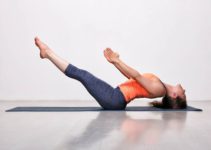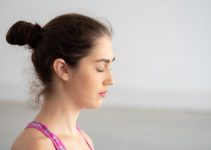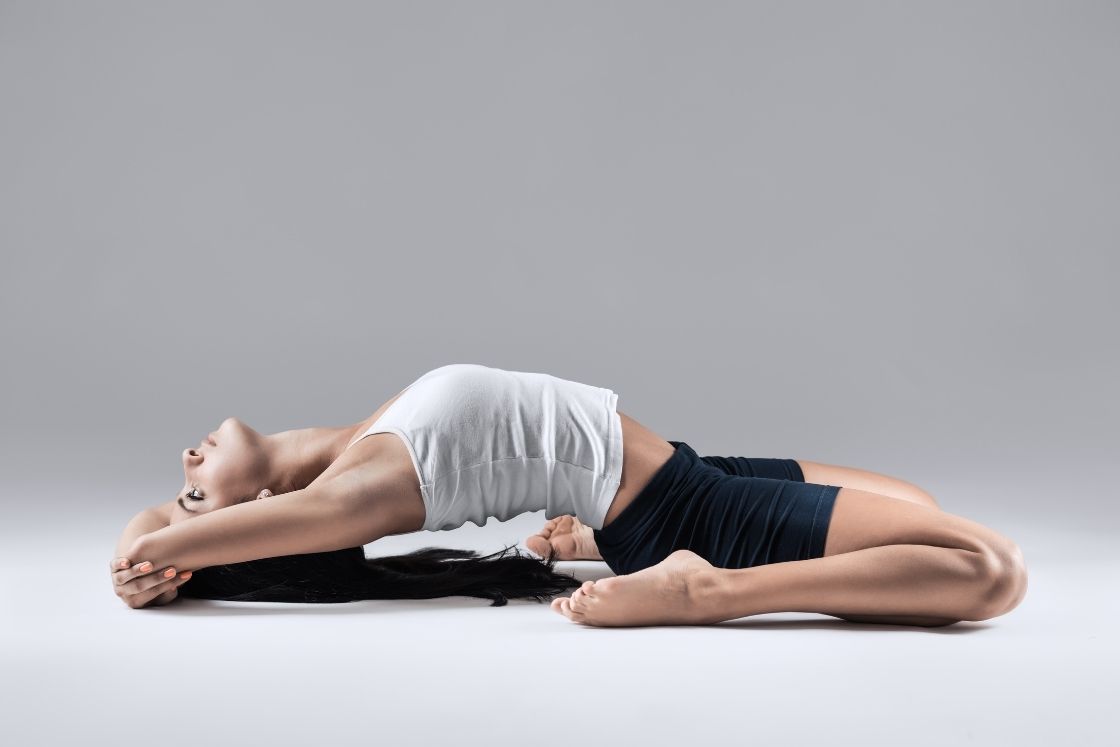
Supta virasana is an advanced variation of virasana. In this pose, the body is fully reclined on the floor from seated virasana.
It is practiced in the supine position and involves backbend. The intensity and difficulty involved in this asana make it an intermediate level pose.
Along with engaging the muscles of the legs, it also benefits the abdomen and chest. It improves the overall body posture of the practitioner.
Meaning & Interpretation
Supta virasana describes a state of the body where it lies in a position that looks similar to a sleeping (Supta) body. Here ‘supta‘ means ‘reclining’, the position of the sleeping body, and ‘vira’ means ‘hero’.
The pose initiates with the base pose in a sitting posture, i.e. virasana, and then leaning back until the head and back reach the floor.
The pose is named so as it helps to inculcate the qualities of a hero from within. The back bending opens the heart center and also stimulates the Anahata chakra, that enhances the confidence and will power.
Supta Virasana Practice Guide
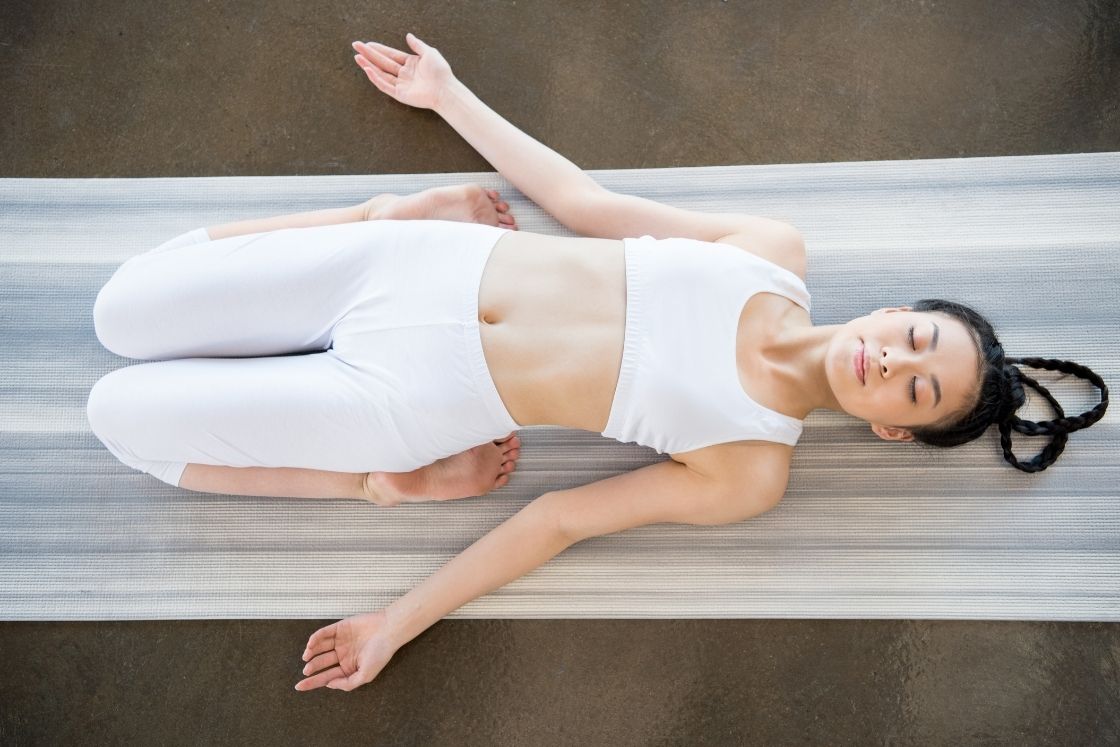
Precautions & Contraindications
- Avoid practicing supta virasana if you have issues with the back, knee, or ankle.
- Never practice it if have angina.
- Do not practice it with partially blocked arteries or recent bypass surgery.
- Discontinue practicing supta virasana if you feel pain in sitting on the virasana
- Do not spread your feet wider than the hips
- Always perform the asana on empty stomach.
Preparatory poses
- Cobra Pose (Bhujangasana)
- Bridge Pose Variation Ankles (Setubandha Sarvangasana Variation Ankles)
- Hero pose (Virasana)
- Bound Angle Pose (Baddha Konasana)
How to Do Supta Virasana (Steps)
- Sit in Vajrasana on your mat.
- Stand on your knees and bring them closer to spread your feet wide apart.
- Turn your calves outwards using your hands and place your buttocks in between the heels. It’s Virasana posture.
- Press your elbows to the floor, exhale, and start leaning back.
- Bring your hands to your heels and lie down on your back.
- Inhale and raise your arms and extend them overhead with the palms facing upwards.
- Keep breathing and stay in the pose for 30-60 seconds.
- Inhale and bring your arms backs to the heels.
- By pressing the elbows, come back up.
- Bring your hands to your knees.
- Stand on your knees and bring the feet together.
- Sit in Virasana and relax.
Beginner’s tips
- While holding the pose the thighs tend to slide apart. Try to pull your inner groins into the pelvis.
- It might be difficult to release out of the pose initially. In this case, roll on to your side and extend your legs out.
Follow-up poses
- Lotus pose (Padmasana)
- Child pose (Balasana)
- Bound Angle Pose (Baddha Konasana)
- Crane Pose (Bakasana)
Modifications and Props
In Supine hero pose, props can be used in different ways to align and hold the proper position of body;
- Yoga block – While leaning backward place a block under your hips. It will prevent the hip from lifting off the floor.
- Yoga strap – For preventing the thighs sliding apart while holding the pose bind your thighs together with a strap.
- Bolster – You can perform Supta Virasana by keeping a bolster on your back. Here, when you lean back you can rest your head and back on the bolster.
- Bolster with blocks – Keep two blocks under the bolster one vertically and the other horizontally. Making this stand by the blocks and put the bolster obliquely on it. Now, lean back on it, this will keep the knees together and grounded.
- Yoga strap aerially – For this hang a strap above your head. As you lean back you can raise your hands and hold the strap, this helps in maintaining balance while leaning on the back.
Supta Virasana Variations
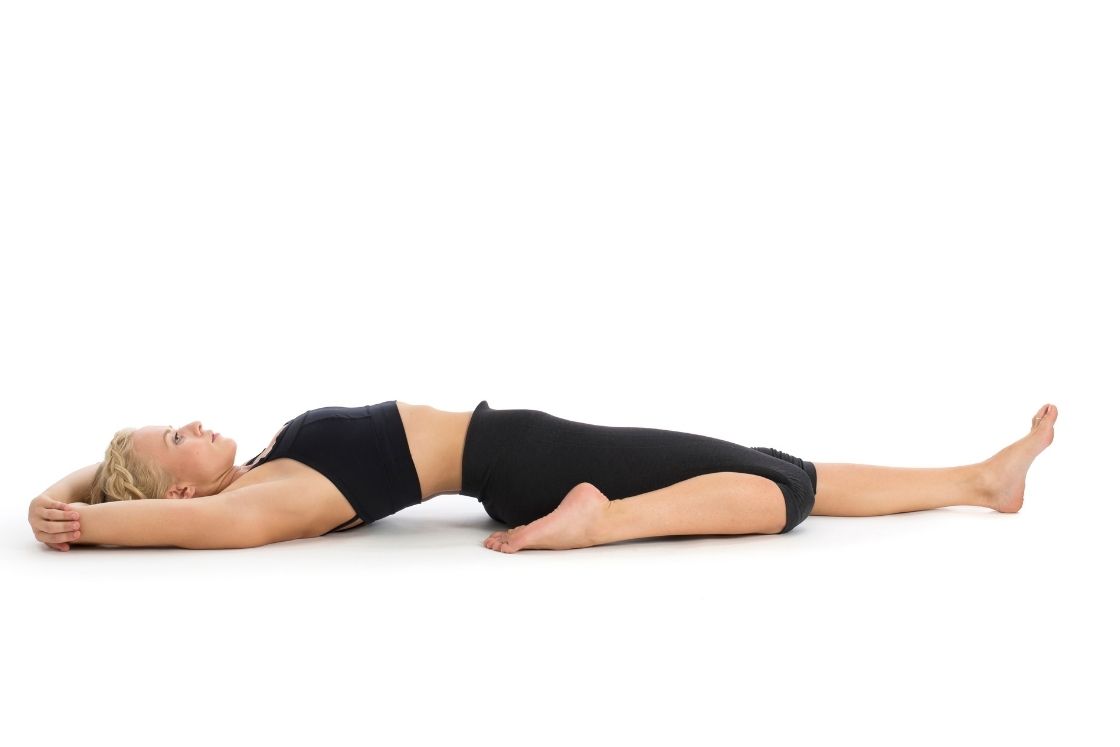
- Supta virasana variation elbows – In this variation, you can hold the pose by leaning backward placing the elbows on the floor. There is no need to bring the head to the floor.
- Couch pose – After lying completely on your back in supta virasana bring your arms overhead. Cross your arms placing your hands on opposite elbows.
- Supta virasana variation one leg straight – Perform the virasana with one bent leg and the other leg is kept straight and extended forward.
- Eka pada supta virasna – In this variation, supta virasana is performed on one bent leg. The other leg is raised towards the ceiling. Use your fingers to grab the toes and keep the leg straight.
- Supta Virasana Variation One Bent Leg Raised – After attaining supta virasana one of the bent legs is raised. During it the raised leg is bent on the knee and the foot remains on the floor.
- Supta Virasana Variation hugging one knee – As the name suggest, after attaining the asana one of the bent knees is drawn towards the chest with both the hands hugging the knees.
Supta Virasana Benefits
1. Strengthens the muscles
Supta virasana stretches the muscles of the back, hips, abdomen, and legs. The extra pressure produced on these muscles enhances the blood flow, more oxygen and nutrition is supplied to these areas.
This is beneficial in strengthening the muscles involved in the asana.
2. Flexibility and pain reliever
Getting into the supta virasana contracts the spinal muscles and stretches them at the same time. It makes the spine stronger and flexible. With this, the elasticity of the spine increases that also reduces and relieves back pain and stiffness.
3. Improves blood circulation
Holding the pose helps in opening the chest muscles that in turn opens the heart center. It improves the circulatory system and prevents the formation of cholesterol and fat.
4. Improves digestion
Supta virasana exerts pressure on abdominal organs that produces stress hormone in the body. Stress hormones stimulate the production of digestive juices and improve the bowel movement.
Therefore, asana facilitates the functioning of the digestive system. It also prevents constipation and other digestive disorders. According to a study, the asana helps get rid of irritable bowel syndrome (IBS).
5. Enhances sexual health
This asana involves stretching of the sexual organs that produce stress hormones in that region. It activates the sexual organs and enhances blood flow towards them. This helps in increasing sexual performance.
Practicing this asana also helps to prevent and cure infertility.
6. Relieves stress
Supta virasana also provides benefits to mental health. It activates the parasympathetic nervous system. It increases the amount of oxygen reaching the brain and leaves calming effects.
A scientific study proves that this reclining variation of virasana helps in relieving stress, anxiety, or other mental issues.
7. Provide energetic benefits
It involves the opening of the navel center. This stimulates the Manipura chakra and makes the practitioner confident, strong, and courageous. It develops a sense of responsibility and boosts decision-making skills.
8. Therapeutic benefits
Supta Virasana has therapeutic benefits for many medical conditions. People suffering from insomnia, flat feet, and high blood pressure can benefit from practicing it. This asana is also beneficial in curing headaches. Scientific studies support these claims. Patients with sciatica and arthritis also experience healing effects from performing this asana.
